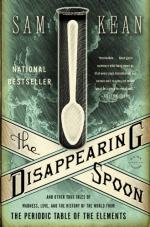|
This section contains 699 words (approx. 2 pages at 400 words per page) |

|
Summary
Chapter 16: This chapter is about how elements behave in extremely cold temperatures. Tin, for example, corrodes and erodes. Robert Falcon Scott and his team, who set out to be the first to reach the South Pole, may have perished on the journey because the tin in his canisters of kerosene had eroded and allowed the fuel to leak away. When matter gets very cold it can shift from one state to another, such as from a liquid to a solid. In some cases, the distinction between mass and energy breaks down, creating complex states of matter and compounds. Kean then explains the science behind lasers and the uncertainty principle, which says that if you know a particle's position very well, you cannot know its momentum well at all, and vice versa. Satyendra Nath Bose and Albert Einstein theorized that if atoms...
(read more from the Part V: Chapters 16-17 Summary)
|
This section contains 699 words (approx. 2 pages at 400 words per page) |

|




